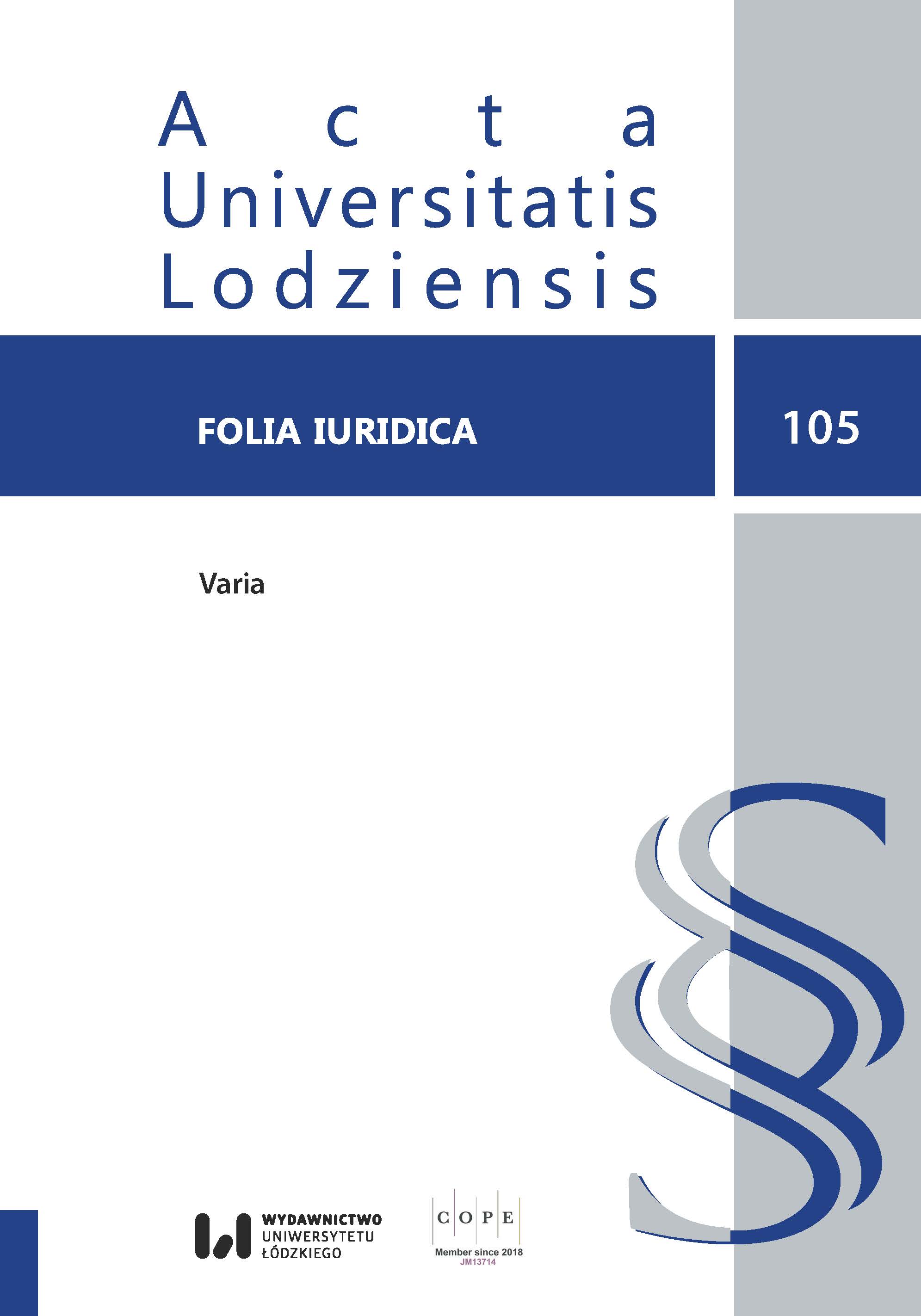Od faworyzowania roli matki do wspólnego rodzicielstwa: dobro dziecka. Doświadczenia amerykańskie
DOI:
https://doi.org/10.18778/0208-6069.105.12Słowa kluczowe:
rozwód, separacja, władza rodzicielska, rodzicielstwo, dobro dzieckaAbstrakt
Przedmiotem niniejszego artykułu jest władza rodzicielska nad dzieckiem po rozwodzie lub w sytuacji rodziców żyjących w rozłączeniu w kontekście zachodzących przemian społecznych. Szczególna uwaga została poświęcona zasadzie dobra dziecka, która jest najważniejszym kryterium przy decydowaniu o wykonywaniu władzy rodzicielskiej. Dobro dziecka jest klauzulą generalną, a sądom orzekającym o władzy rodzicielskiej przysługuje szeroka swoboda kontekście za celowe uznano sięgnięcie do doświadczeń amerykańskich związanych z rozstrzyganiem o władzy rodzicielskiej po rozwodzie lub rozstaniu rodziców. W Stanach Zjednoczonych powstawały różne teorie, które miały tłumaczyć, jaki model władzy rodzicielskiej najlepiej realizuje postulat dobra dziecka. W artykule omówiono teorię wrażliwych lat, teorię podstawowego opiekuna, teorię psychologicznego rodzica oraz tzw. approximation rule. Po rozwodzie zwykle to matce była powierzana władza rodzicielska, a rola ojca sprowadzała się do obowiązku alimentacji. Ojciec był traktowany jako rodzic drugoplanowy i wyłączany był ze sprawowania bieżącej pieczy nad dzieckiem. Obecnie odchodzi się od tradycyjnego modelu matki – opiekuna i ojca – żywiciela rodziny. Zachodzące zmiany mają również swoje odzwierciedlenie w walce o równouprawnienie przy decydowaniu o władzy rodzicielskiej oraz zwalczaniu stereotypów sprowadzających się do automatycznego przyznawania tej władzy matkom. Obecnie obserwuje się wzrost orzeczeń sądów rodzinnych przyznających pełnię władzy rodzicielskiej obojgu rodzicom.
Pobrania
Bibliografia
Atwell, Anthony E. Ursula S. Moore. Evan Nielsen. Ziva Levite. 1984. “Effects of Joint Custody on Children.” The Journal of the American Academy of Psychiatry and the Law 12(2): 149–157.
Google Scholar
Bratt, Carolyn. S. 1978–1979. “Joint Custody.” Kentucky Law Journal 67(2): 271–308.
Google Scholar
Bratton, Robert M. 1981. “Joint Custody in Kentucky.” Northern Kentucky Law Review 8(3): 553–576.
Google Scholar
DiFonzo, Herbie J. 2015. “Dilemmas of Shared Parenting in the 21st Century: How Law and Culture Shape Child Custody.” Hofstra Law Review 43(4): 1003–1024.
Google Scholar
Forman, Deborah L. 2019. “Legal Relationships Between Adults and Children in the United States of America.” In Adults and Children in Postmodern Societies. A Comparative Law and Multidisciplinary Handbook. Edited by Jehanne Sosson, Geoffrey Willems, Gwendoline Motte. 583–622. Cambridge: Intersentia. https://doi.org/10.1017/9781780688480.021
Google Scholar
Goldstein, Joseph. Anna Freud. Albert J. Solnit. 1979. Beyond the Best Interests of the Child (New Edition with Epilogue). New York: Free Press.
Google Scholar
Hawkins, Lois E. 1982. “Joint Custody in Louisiana.” Louisiana Law Review 43(1): 85–118.
Google Scholar
Kurki-Suonio, Kirsti. 2000. “Joint Custody as an Interpretation of the Best Interests of the Child in Critical and Comparative Perspective.” International Journal of Law, Policy and the Family 14(3): 183–205. https://doi.org/10.1093/lawfam/14.3.183
Google Scholar
Lapsatis, Nicole. 2012. “In the Best Interests of No One: How New York’s Best Interests of the Child Violates Parents’ Fundamental Right to the Care, Custody, and Control of Their Children.” St. John’s Law Review 86(2 & 3): 673–714.
Google Scholar
Mason, Mary A. Ann Quirk. 1997. “Are Mothers Losing Custody – Read My Lips: Trends in Judicial Decision-making in Custody Disputes – 1920, 1960, 1990, and 1995.” Family Law Quarterly 31(2): 215–236.
Google Scholar
McCall, Shawn. 2019. “Bringing Specificity to Child Custody Provisions in California.” Golden Gate University Law Review 49(2): 141–168.
Google Scholar
Miller, David J. 1979. “Joint Custody.” Family Law Quarterly 13(3): 345–412.
Google Scholar
Mnookin. Robert. 2014. “Child Custody Revisited.” Law and Contemporary Problems 77(1): 249– 274.
Google Scholar
Nielsen, Linda. 2015. “Shared Physical Custody: Does It Benefit Most Children?” Journal of the American Academy of Matrimonial Lawyers 28(1): 79–138.
Google Scholar
Opie, Anne. 1993. “Ideologies of Joint Custody.” Family and Conciliation Courts Review 31(3): 313–326. https://doi.org/10.1111/j.174-1617.1993.tb00307.x
Google Scholar
Sanders, Molly. 2010. “Should Child Custody Awards Be Based on Past Caretaking: The Effect of the Approximation Standard Ten Years after Its Adoption.” Children’s Legal Rights Journal 30(3): 17–35.
Google Scholar
Schrama, Wendy M. 2009. “Family Function over Family Form in the Law on Parentage. The Legal Position of Children Born in Informal Relationships.” In Debates in Family Law around the Globe at the Dawn of the 21st Century. Edited by Katharina Boele-Woelki. 123–144. Antwerp: Intersentia.
Google Scholar
Scott, Elizabeth S. 1992. “Pluralism, Paternal Preference, and Child Custody.” Columbia Law School 80: 615–672. https://doi.org/10.2307/3480710
Google Scholar
Steinbach, Anja. Lara Augustijn. Gerrit Corkadi. 2020. “Joint Physical Custody and Adolescent’s Life Satisfaction in 37 North American and European Countries.” Family Process: 1–14. https://doi.org/10.1111/famp.12536
Google Scholar
Sünderhauf, Hildegund. 2013. “Vorurteile gegen das Wechselmodell: Was stimmt, was nicht? – Argumente in der Rechtsprechung und Erkenntnisse aus der psychologischen Forschung.” FamRB-Beratungspraxis. Aktuelle Praxisfragen 9: 290–335.
Google Scholar
Trout, Linda. 1984. “Missouri Joint Custody Law.” UMKC Law Review 52(4): 625–640.
Google Scholar
Pobrania
Opublikowane
Wersje
- 2024-02-15 - (2)
- 2023-12-22 - (1)
Jak cytować
Numer
Dział
Licencja

Utwór dostępny jest na licencji Creative Commons Uznanie autorstwa – Użycie niekomercyjne – Bez utworów zależnych 4.0 Międzynarodowe.
Funding data
-
Narodowe Centrum Nauki
Grant numbers DEC-2019/33/N/HS5/00284













